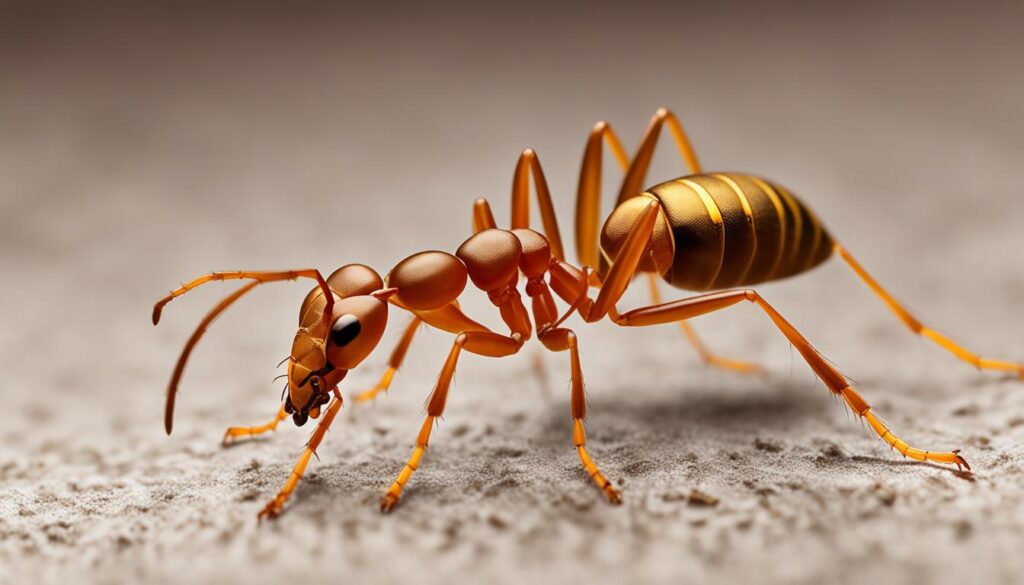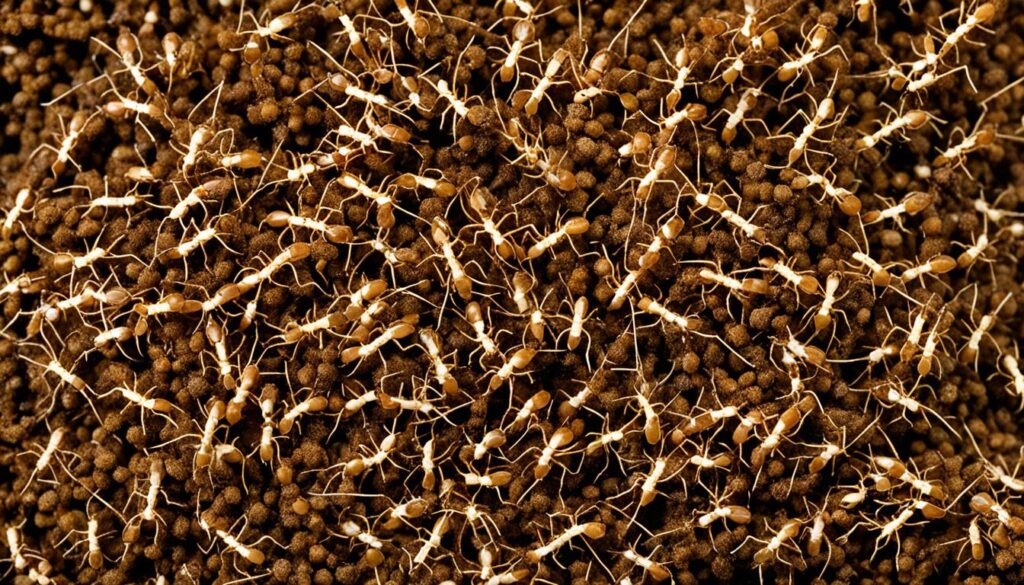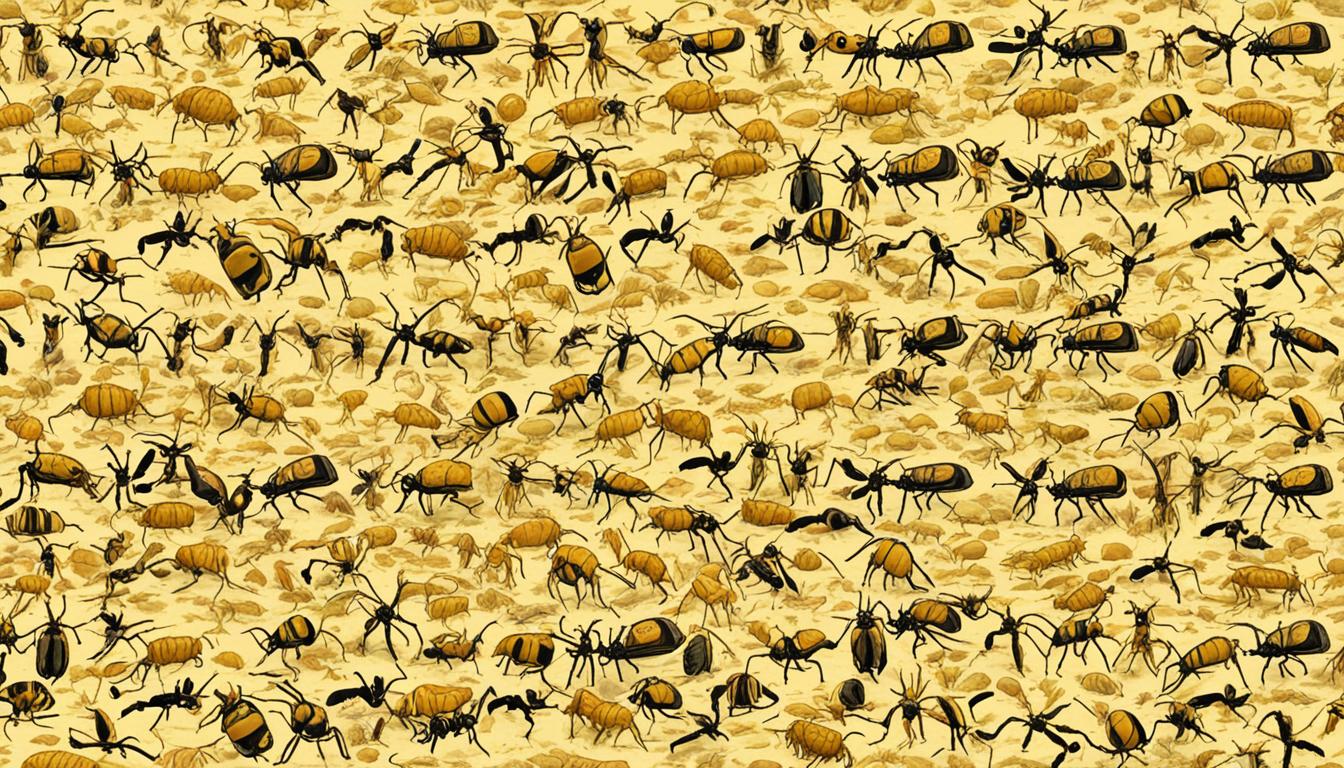Did you know the Pharaoh ant is tough to control? It’s called Monomorium pharaonis. This invasive ant has spread worldwide due to trade. It’s a big problem for both homes and businesses.
This guide will teach you about Pharaoh ants. You’ll learn their names, where they live, and why they’re hard to get rid of. Knowing about these ants helps to deal with them better.
The Pharaoh ant, scientifically known as Monomorium pharaonis, is the only species within its genus commonly referred to as a Pharaoh ant. These little ants are usually yellow or light brown in color, and they are notorious for being invasive, especially in areas where people live. Their capacity to build several queen colonies and their tenacious disposition have earned them a reputation for being difficult to manage.
Pharaoh Ant Names & Related Species
However, I’ll provide you with the information about this species and related ones:
- Monomorium pharaonis
This is the scientific name for the Pharaoh ant. It’s the only species commonly referred to as the “Pharaoh ant.”
While there are no other species specifically called “Pharaoh ants,” there are many other species in the genus Monomorium. Some of these include:
- Monomorium floricola
- Monomorium minimum
- Monomorium destructor
- Monomorium antarcticum
- Monomorium latinode
- Monomorium subopacum
- Monomorium monomorium
- Monomorium salomonis
- Monomorium indicum
These species are not specifically called “Pharaoh ants,” but they belong to the same genus as the Pharaoh ant.
It’s important to note that the genus Monomorium contains over 300 described species, and new species are still being discovered. The list above includes some of the more well-known or common species, but it is far from exhaustive.
Scientific Name and Common Name
The Pharaoh ant is known scientifically as Monomorium pharaonis (Linnaeus). It’s a tiny household pest ant seen all over the world. The name refers to its small, single-sized workers. It’s also called Pharaoh ant because of a story linking it to ancient Egypt plagues.
Distribution and Habitat
The Monomorium pharaonis ant has spread worldwide through trade. Although Africa might be its home, it rarely nests outside, especially not in cold places.
It thrives inside heated buildings such as those in southern Florida. This makes it a common invader of homes worldwide.
Pharaoh ants workers are 2 millimetres long, and queens are about 4mm. A colony may have up to 2,500 workers. The queen can live up to a year and lay 400 eggs. It takes around 36 to 42 days for eggs to become fully grown ants. And new ants can be born twice a year.
These ants are a big problem in many places. Places like hospitals, homes, and food spots are at risk. In hospitals, they can spread more than 12 diseases. One big issue is how they quickly make new colonies and spread to new areas.
They like to live in warm, wet spots indoors, near water or wires. Getting rid of them can take from a few months to a year. This is because they have many nests.

Physical Characteristics of Pharaoh Ants
The Pharaoh ant, Monomorium pharaonis, is well-known. It belongs to the Monomorium genus. Several species of Monomorium are also “tramp ants” found worldwide. Yet, M. pharaonis is the biggest pest ant. They are tiny, love to hide, and build fast-growing clans.
Monomorium pharaonis (Linnaeus) is very hard to stop at home. These ants are usually 1.5 to 2 mm in size. Their groups can range from a few to hundreds of thousands. Queens lay over 400 eggs each and can live up to a year.
Male and queen ants mate in their nest. It takes about 42 days to grow from an egg into an adult. They carry many germs, like Salmonella spp. and Streptococcus spp. This makes them a big worry in places like hospitals and homes.
| Characteristic | Measurement |
|---|---|
| Worker Length | 1.5 to 2 mm |
| Queen Length | 3.6 to 5.0 mm |
| Egg Hatch Time | 5 to 7 days |
| Larval Period | 18 to 19 days |
| Pre-pupal Period | 3 days |
| Pupal Period | 9 days |
| Time to Sexual Maturity | 38 to 45 days |
Baits and insect growth products help fight Pharaoh ant groups. These ants love sweet and greasy foods. They’re everywhere because of their smart nests and colonies.

Identification and Biology
The Pharaoh ant is known as the Monomorium pharaonis. It is a tiny but very bothersome pest. This ant can be found nearly everywhere in the world. Knowing how these ants look and act is key to stopping them.
Physical Characteristics
Pharaoh ant workers are all about the same size, usually 1.2 to 2 mm long. They have 12 segment antennae with a 3-segment club, small eyes, and a distinct marking on their middle body part. They can be yellowish-brown to reddish-brown, with darker abdomens. Pharaoh ants can sting but hardly ever do.
Queens of the Monomorium pharaonis are a bit bigger than workers, around 2 mm long, and a bit darker. Male Pharaoh ants are even bigger, at about 3 mm.
Nesting and Foraging Habits
Pharaoh ant colonies can grow very large, from a few dozen to several hundred thousand ants. They like warm, damp places close to food and water, like wall voids. Each colony can have more than one queen.
These ants multiply quickly. A queen can lay over 400 eggs. They also bud, creating new nests. This makes them hard to get rid of. They can make many colonies in a building.
Pharaoh ant workers travel far from their nests, up to hundreds of feet. They follow trails marked with chemicals to find food. They eat mostly protein but can eat many things.
| Characteristic | Measurement |
|---|---|
| Worker Size | 1.2 – 2 mm |
| Queen Size | Around 2 mm |
| Male Size | Approximately 3 mm |
| Colony Size | Few dozen to several hundred thousand individuals |
| Egg Production | Over 400 eggs per queen |
The Pharaoh ant, Monomorium pharaonis, is a tiny but strong pest. It can build big colonies that are hard to control. Knowing its traits helps in dealing with this ant.
Conclusion
The Pharaoh ant, Monomorium pharaonis, is a big problem in homes. It’s small and likes to live in hidden spots. This ant makes very large colonies, which are hard to control. Knowing about its life and using the right ant control methods is key for anyone fighting Pharaoh ants.
This ant has been found in more than 1,200 places. It’s a big issue in warm buildings and hospitals. The ant can spread diseases. It loves warm, moist places and grows fast. This makes it tough to get rid of.
Using baits and special regulators is better than just sprays. But, getting help from experts is best. They can safely and effectively manage Pharaoh ant problems. This keeps everyone safe and happy.

